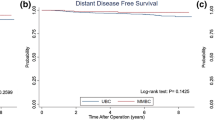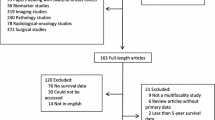Abstract
For classification of breast cancer (BC), tumor-node-metastasis (TNM) staging has been considered state of the art for more than 50 years. The T category is well defined, and in multicentric and multifocal tumors, tumor size is assessed by the largest tumor focus. The aim of this study was to compare multicentric/multifocal tumor spread in breast cancer with unifocal disease and to evaluate the diagnostic relevance of multifocality. A retrospective analysis was performed on survival related events in a series of 5,691 breast cancer patients between 1963 and 2007. By matched-pair analysis, patients were entered into two comparable groups of 288 patients after categorizing them as having multifocal/multicentric or unifocal breast cancers. Matching criteria were tumor size, grading, and hormone receptor status, which were equally distributed between both groups (P = 1.000 each). Disease free survival and the occurrence of relapse or of metastatic disease were evaluated. Cox’s regression analysis was used for multivariate analysis. In the unifocal group, the mean breast cancer-specific survival time was 221.6 months as opposed to 203.3 months in the multicentric/multifocal group (P < 0.001, log-rank test). The occurrence of local relapse and distant metastasis was significantly increased in the multifocal group in comparison to the unifocal equivalent group (P < 0.001 and P < 0.003, respectively). Cox regression analysis for multivariate analyses demonstrated focality and centricity to be highly significant predictors for reduced overall survival (P = 0.016), local relapse (P = 0.001) and distant metastasis (P = 0.038). Tumor size, histopathological grading, hormone receptor status, and staging of lymph nodes are well-established prognostic parameters. Additionally, the number of foci should be considered as an independent prognostic parameter, which is currently not reflected in the TNM classification. We conclude that multicentric/multifocal BC is an independent BC risk factor and should be included in the risk assessment by re-evaluating the current TNM classification of the UICC.







Similar content being viewed by others
References
Benson JR, Weaver DL, Mittra I, Hayashi M (2003) The TNM staging system and breast cancer. Lancet Oncol 4(1):56–60
Cserni G, Kulka J (2003) New TNM classification of breast tumors. Orv Hetil 144(32):1563–1568
Escobar PF, Patrick RJ, Rybicki LA, Weng DE, Crowe JP (2007) The 2003 revised TNM staging system for breast cancer: results of stage re-classification on survival and future comparisons among stage groups. Ann Surg Oncol 14(1):143–147
Veronesi U, Viale G, Rotmensz N, Goldhirsch A, Rethinking TNM (2006) breast cancer TNM classification for treatment decision-making and research. Breast 15(1):3–8
Bundred NJ (2001) Prognostic and predictive factors in breast cancer. Cancer Treat Rev 27(3):137–142
Dabakuyo TS, Bonnetain F, Roignot P, Poillot ML, Chaplain G, Altwegg T, Hedelin G, Arveux P (2008) Population-based study of breast cancer survival in Cote d’Or (France): prognostic factors and relative survival. Ann Oncol 19(2):276–283
Younes M, Lane M, Miller CC, Laucirica R (1997) Stratified multivariate analysis of prognostic markers in breast cancer a: preliminary report. Anticancer Res 17(2B):1383–1390
Duraker N, Caynak ZC (2005) Prognostic value of the 2002 TNM classification for breast carcinoma with regard to the number of metastatic axillary lymph nodes. Cancer 104(4):700–707
Garcia-Vilanova Comas A, Garcia Vilanova A, Fuster-Diana E, Martinez-Alzamora N, Fernandez-Tena J, Garcia-Vilanova Comas J, Garcia-Vilanova Comas M (2006) Prognostic value of the interpectoral lymph nodes in breast cancer. A 20-year survival study. Clin Transl Oncol 8(2):108–118
Wanami LS, Chen HY, Peiro S, Garcia de Herreros A, Bachelder RE (2008) Vascular endothelial growth factor-A stimulates snail expression in breast tumor cells: Implications for tumor progression. Exp Cell Res 314(13):2448–2453
Wang J, Barnes RO, West NR, Olson M, Chu JE, Watson PH (2008) Jab1 is a target of EGFR signaling in ER-alpha negative breast cancer. Breast Cancer Res 10(3):R51
Yildirim Y, Gunel N, Coskun U, Sancak B, Bukan N, Aslan S, Cetin A (2008) Serum big endothelin-1 levels in female patients with breast cancer. Int Immunopharmacol 8(8):1119–1123
Sobin LH, Hermanek P, Hutter RV (1988) TNM classification of malignant tumors. A comparison between the new (1987) and the old editions. Cancer 61(11):2310–2314
Altmann U, Haeberlin V, Tafazzoli A, Dudeck J (1997) Application of a standard methodology for the development of messages and aspects of realization in the area of tumour documentation. Stud Health Technol Inf 43 Pt B:776–780
Gusterson BA (2003) The new TNM classification and micrometastases. Breast 12(6):387–390
Johnson A (2006) TNM classification Veronesi et al. Breast 15(5):580
Savran VR, Fetsych TH, Savran VV, Tril OV, Myshakivs’kyi OM (2006) Stages of breast cancer. Lik Sprava 3:11–17
Singletary SE, Greene FL (2003) Revision of breast cancer staging: the 6th edition of the TNM classification. Semin Surg Oncol 21(1):53–59
Gentilini O, Botteri E, Rotmensz N, Da Lima L, Caliskan M, Garcia-Etienne CA, Sosnovskikh I, Intra M, Mazzarol G, Musmeci S et al. (2009) Conservative surgery in patients with multifocal/multicentric breast cancer. Breast Cancer Res Treat 113(3):577–583
Gentilini O, Veronesi P, Gatti G, Intra M, Mazzarol G, Trifiro G, Bassi F, Caliskan M, Da Lima L, Galimberti V et al (2007) Conservative approach for breast cancer. The experience of the European Institute of Oncology. Minerva Chir 62(6):447–458
Spinelli C, Berti P, Ricci E, Miccoli P (1992) Multicentric breast tumour: an anatomical-clinical study of 100 cases. Eur J Surg Oncol 18(1):23–26
Wakabayashi T, Tsuchiya SI, Asano G (1995) Unilateral multicentric breast carcinoma studied by whole mammary gland serial sectioning. Breast Cancer 2(2):91–98
Fowble B, Yeh IT, Schultz DJ, Solin LJ, Rosato EF, Jardines L, Hoffman J, Eisenberg B, Weiss MC, Hanks G (1993) The role of mastectomy in patients with stage I–II breast cancer presenting with gross multifocal or multicentric disease or diffuse microclassifications. Int J Radiat Oncol Biol Phys 27(3):567–573
Andea AA, Bouwman D, Wallis T, Visscher DW (2004) Correlation of tumor volume and surface area with lymph node status in patients with multifocal/multicentric breast carcinoma. Cancer 100(1):20–27
Andea AA, Wallis T, Newman LA, Bouwman D, Dey J, Visscher DW (2002) Pathologic analysis of tumor size and lymph node status in multifocal/multicentric breast carcinoma. Cancer 94(5):1383–1390
Sobin LH, Greene FL (2003) Pathologic analysis of tumor size and lymph node status in multifocal/multicentric breast carcinoma. Cancer 97(5):1364 (author reply 1365)
Sobin LH, Greene FL (2004) Multifocal/multicentric breast carcinoma. Cancer 100(11):2488–2489 (author reply 2489)
Vlastos G, Rubio IT, Mirza NQ, Newman LA, Aurora R, Alderfer J, Buzdar AU, Singletary SE (2000) Impact of multicentricity on clinical outcome in patients with T1–2, N0–1, M0 breast cancer. Ann Surg Oncol 7(8):581–587
Coombs NJ, Boyages J (2005) Multifocal and multicentric breast cancer: does each focus matter? J Clin Oncol 23(30):7497–7502
Fajdic J, Bukovic D, Gugic D, Habek M, Hojsak I, Bukovic N, Herman I, Stanceric T (2003) Unilateral multicentric breast cancer. Coll Antropol 27(2):693–698
Oh JL, Dryden MJ, Woodward WA, Yu TK, Tereffe W, Strom EA, Perkins GH, Middleton L, Hunt KK, Giordano SH et al (2006) Locoregional control of clinically diagnosed multifocal or multicentric breast cancer after neoadjuvant chemotherapy and locoregional therapy. J Clin Oncol 24(31):4971–4975
Anastassiades O, Iakovou E, Stavridou N, Gogas J, Karameris A (1993) Multicentricity in breast cancer. A study of 366 cases. Am J Clin Pathol 99(3):238–243
Acknowledgment
We would like to thank Dr. Steven S. Witkin (Weill Cornell Medical College, New York, USA) for his help with the manuscript.
Author information
Authors and Affiliations
Corresponding author
Rights and permissions
About this article
Cite this article
Weissenbacher, T.M., Zschage, M., Janni, W. et al. Multicentric and multifocal versus unifocal breast cancer: is the tumor-node-metastasis classification justified?. Breast Cancer Res Treat 122, 27–34 (2010). https://doi.org/10.1007/s10549-010-0917-9
Received:
Accepted:
Published:
Issue Date:
DOI: https://doi.org/10.1007/s10549-010-0917-9




